How GM, Chrysler, and AMC Reacted to the Original Ford Mustang
April 17 marks sixty years since the Ford Mustang’s public debut at the 1964 New York World’s Fair. The original pony car immediately became a pop-culture and automotive phenom, and it remains one of the most impactful cars in history. We’re celebrating with stories of the events surrounding the Mustang’s launch, the history of the early cars, and tales from owners. Click here to follow along with our multi-week 60 Years of Mustang coverage. -Ed.
Car people over a certain age certainly remember the April 1964 debut of Ford’s first Mustang. Enthusiasts yawned at first due to the car’s lowly Falcon-based platform and powertrains, but most were eventually charmed by its sporty looks, multiple appealing options, and affordable pricing.
U.S. auto executives outside the Blue Oval wondered whether to take it seriously. Bob Lutz (who would later rise to top leadership levels at Ford, Chrysler, and General Motors) had been working at GM Overseas Operations (GMOO) for a bit more than a year when Mustang was launched. “The clan of car guys l hung out with agreed it was a genius marketing move,” he tells Hagerty. “We didn’t admire it as a car because of its down-and-nasty Falcon architecture, but we agreed it would be a hit. We underestimated how big of a hit, but so did everyone else. Its appeal was NOT to car guys but to average, low-to-middle-income Americans who saw it as glamorous and aspirational.”
Reaction from GM leadership was initially dismissive. According to Lutz, they calculated the entire U.S. auto sales market at the time at 100,000 units. “Let’s say it’s a smash hit and gets 50 percent of that segment. ‘That’s 50,000 units. Why bother?’ They failed to realize that Ford did not intend [the Mustang to be] part of the ‘sports car’ segment but as cheap, sporty, aspirational family transportation. Once they fully grasped what Ford had pulled off, it was all-hands-on-deck, full speed ahead.”
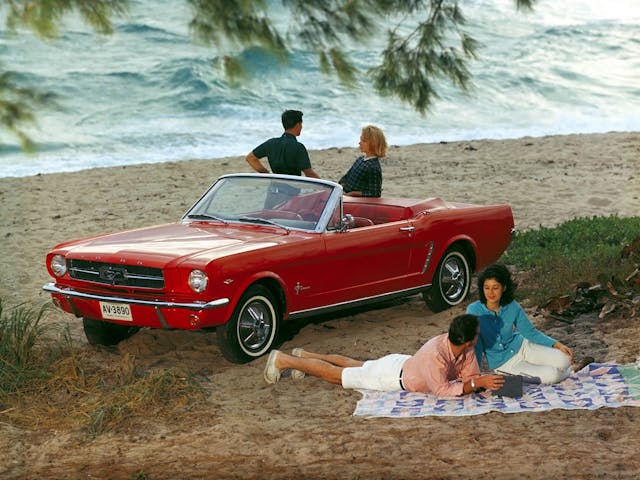
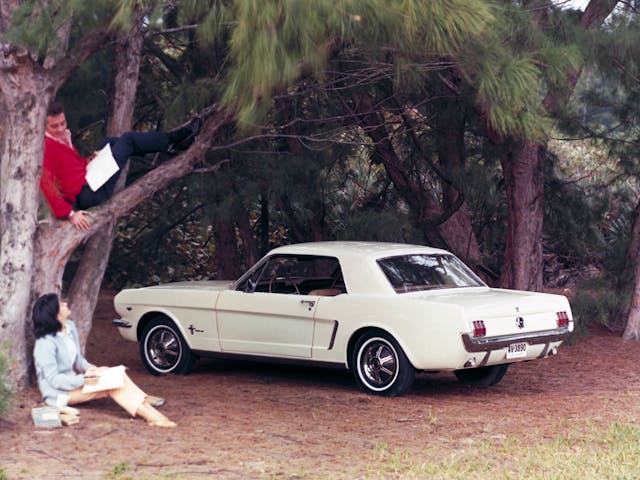
GM and its Chevrolet Division didn’t see that initial ’65 Mustang as a serious threat, but few outside (or even inside) the company knew that Chevy designers had been quietly exploring the same idea of a youthful, sporty compact coupe since soon after the Chevy II debuted for 1962. The project was inspired by the elegant 1963 Buick Riviera “personal coupe” that was launched to take on Ford’s four-seat Thunderbird. Chevrolet styling chief Irv Rybicki wondered whether something similar to the Chevy II in concept but smaller and much more affordable—which could share the Chevy II’s unibody platform and mechanicals—might make sense for Chevrolet. When Rybicki suggested exploring such a car to GM Design Vice President William L. “Bill” Mitchell, Mitchell was intrigued. “By God, that’s not a bad idea!” he reportedly said, “But let’s do it outside the building where no one in the corporation can see what we’re up to.”
“So, we went across the street to our warehouse, created a little room there and started a program,” Rybicki later told us. “And in five months, they had a Chevy II-based clay model dimensionally very close to the future Mustang that no one outside of Ford knew was being developed. But when Rybicki showed it to then-Chevrolet general manager S. E. “Bunkie” Knudsen, Knudsen liked it but decided not to pursue it: “I’ll tell you, fellows,” he said, “one thing we don’t need right now is another car.”

Aside from its popular full-size line, Chevy’s stable at the time included the rear-engine Corvair, the compact Chevy II, the mid-size Malibu, and the Corvette sports car. Rybicki’s proposed sporty compact coupe would add a sixth separate car, and Knudsen didn’t see the need to invest the substantial money, time, and human resources it would take to make that happen.
Rybicki didn’t give up on the idea. Like Ford’s Iacocca, he could see America’s emerging youth market coming. In late 1963, Rybicki had Henry “Hank” Haga’s Chevrolet #2 Studio design a sleek Chevy II-based sporty coupe concept car called “Super Nova.” Mitchell liked it so much that he had it developed into a fiberglass-bodied running car and dispatched it to the April 4, 1964 New York Auto Show, where its appearance two weeks before the Mustang’s April 17 debut at the New York World’s Fair made some Ford folks nervous.
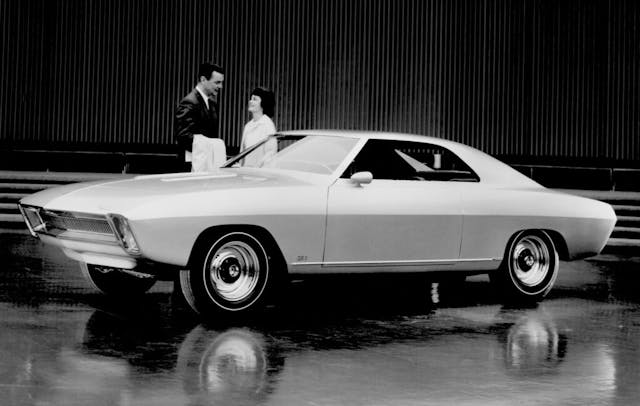
“I recall some of the Ford people coming over while I was standing there and asking whether we were going to build that car,” Knudsen said. “I remarked, ‘If they’ll let us, we’ll build it.’” But when he tried selling it to GM leadership, then-GM president Jack Gordon turned him down.
Camaro/Firebird


When the Mustang bowed to thundering media and public applause, then-Pontiac general manager Elliot M. “Pete” Estes was one GM leader who took it seriously: “I happened to be at Styling when the first Mustang rolled into the garage,” he later recalled. “Everybody was standing around saying what a disaster it was and how market research showed there was no market for it. I didn’t say anything but had a feeling that this thing was going to backfire on us.”
Jerry Palmer, who joined GM Design in 1966 and rose to executive director over all cars and trucks before his 2002 retirement, recalls seeing that first Mustang in its Ford Design studio while still in school at Detroit’s Society of Arts and Crafts (now the College of Creative Studies). “Homer LaGasse, who was on the Mustang design team, arranged a trip for our seniors to go through the studio,” Palmer relates. “The concept was a hot little car, but we were a little disappointed by the actual car.”

Retired GM designer Dick Ruzzin, who had been there for about a year and a half when Mustang was launched, says, on the contrary, that everyone there was surprised. “The design to me was very good as it had some of the character of the recent Lincoln, the sheer slab side and peaked fenders,” he recalls today. “I thought it was a great-looking car, but it was not seen as a performance car in any way. The muscle car era was just beginning, and Mustang responded to that and was part of that movement as it evolved through the years.”

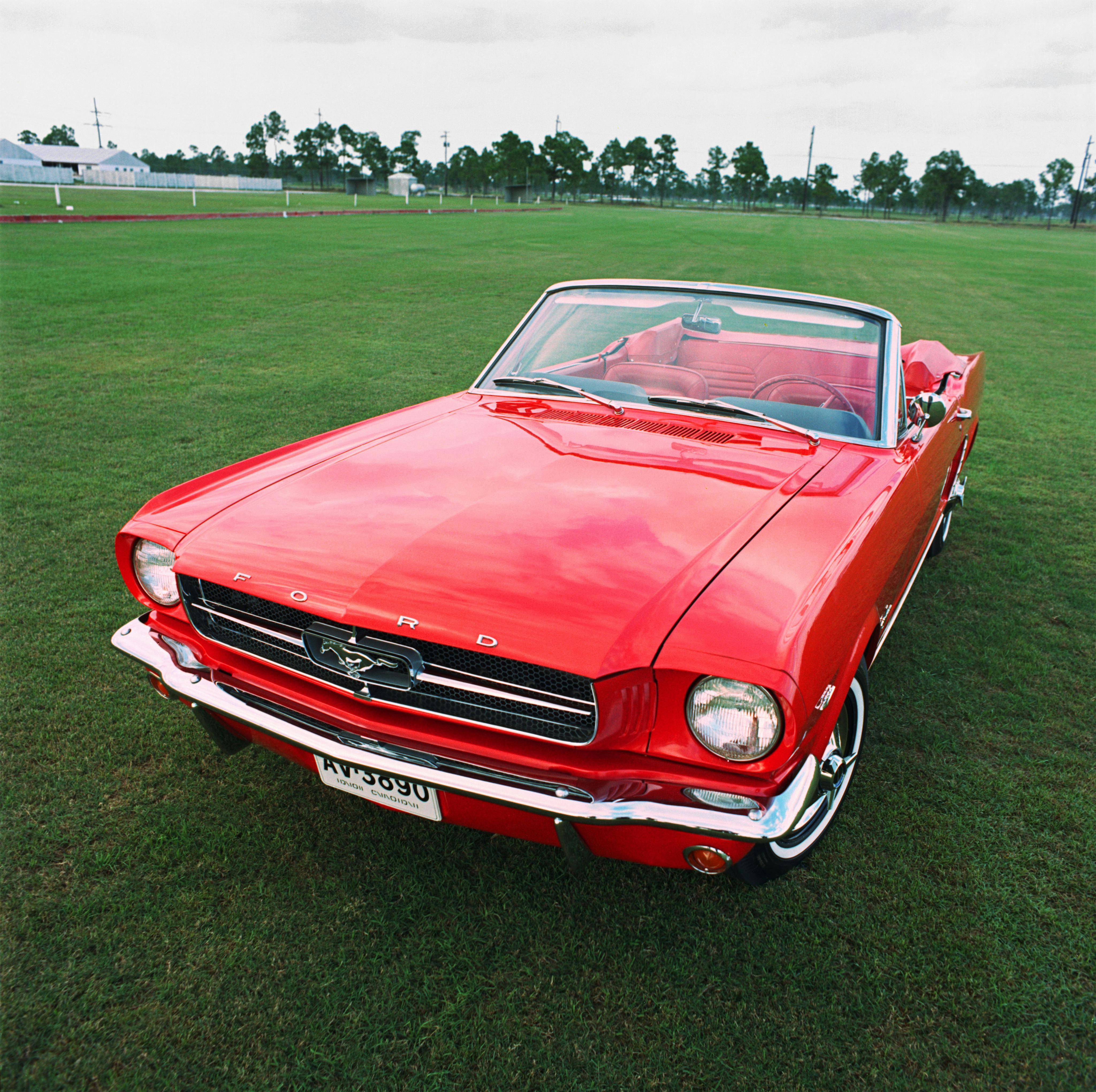
Because the rear-engine compact Corvair was getting a Corvette-look redesign for 1965, GM brass believed that its new style, its bucket-seat Monza coupe and convertible models, and its optional turbocharged engine would help it compete quite well with Ford’s new sporty car. Even Mitchell was telling everyone that the ’65 Corvair was Chevy’s answer to the Mustang.
After Mustang sales topped 100,000 in its first four months alone, with no sign of slowing on its way to the biggest first-year sales success of any new car in history, GM leaders found instant enlightenment. They suddenly decided to hurry up and counter Mustang with the small, sporty coupe and convertible that would become the 1967 Camaro and—partly to appease John DeLorean, who had succeeded Estes as Pontiac general manager and was lobbying hard for a two-seat sports car—a Pontiac variant to be known as the Firebird.
Barracuda/Challenger
Chrysler Corporation actually beat Mustang to market by a couple of weeks with its first Plymouth Barracuda. Believing rumors that Ford was developing a new sporty compact based on its inexpensive Falcon chassis and running gear, Chrysler execs saw an important new market segment and wanted an entry. “Chrysler predicted the ‘specialty compact’ segment would grow to 1.5 million sales by 1970,” Motor Trend reported, “of which it could easily claim 200,000 or more.” With a limited budget, stylist Irv Ritchie sketched the fastback coupe that debuted as a Barracuda option package on the compact Valiant on April 1, 1964.
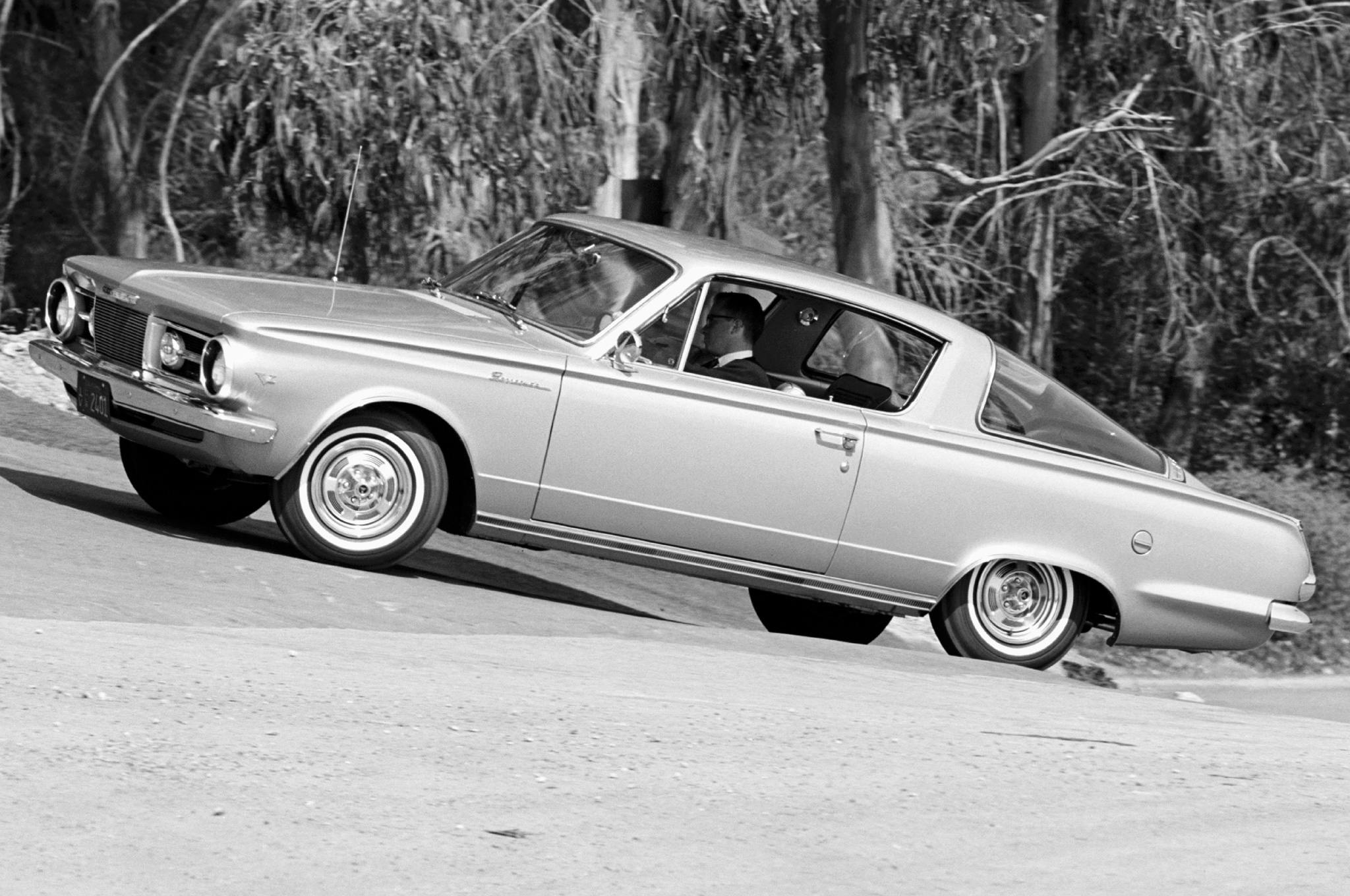

“The 1964 Plymouth Barracuda was essentially a fastback version of the Plymouth Valiant,” wrote Chandler Stark for musclecarclub.com in 2015, “and it was actually marketed as the Plymouth Valiant Barracuda initially. It used the same wheelbase dimensions and Chrysler A-body platform but with a massive wraparound rear window and taillight … At this stage, the Barracuda was more of a budget car …built for convenience and reliability, not performance.”
That hurry-up car was badly outsold by the Mustang, and it took three years to design and develop the much more competitive second-generation Barracuda for ‘67, which (like the Mustang) offered coupe, convertible, and fastback body styles. Three more years later, Chrysler’s Dodge brand jumped in with its slightly larger, more upscale ‘70 Challenger on an all-new shared platform.

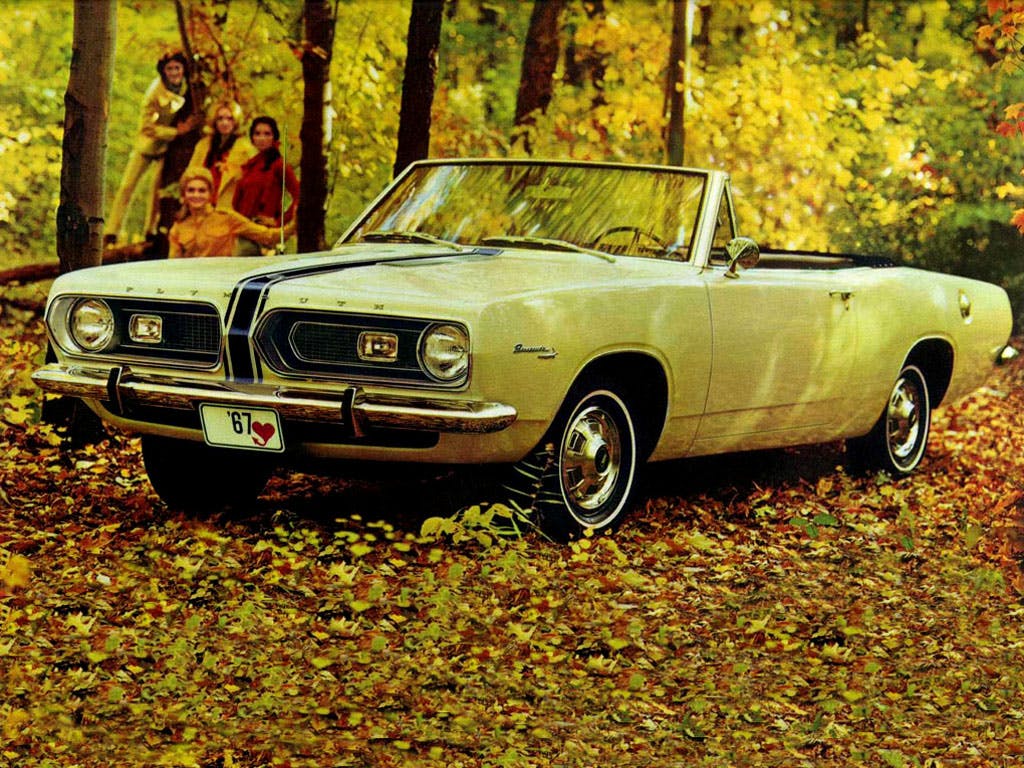

Retired Chrysler Design (and Engineering) vice-president Tom Gale explains that the Mustang arrived a few years before his time there began. “But I was very aware of its impact. For me, the lesson was getting the proportions right, which the Mustang did with its long hood and short deck. The 64-1/2 Mustang, albeit derived from the Falcon, really nailed the proportion with great style and gutsy leadership from Hal Sperlich and Lee Iacocca. Contrast that with the Plymouth Barracuda of the time, where it took until 1967 to make the improved design, which was still based on the A-body Valiant/Dart. But it wasn’t until 1970 with the E-body Barracuda/Challenger that competitors’ cars hit their stride and, in many ways, went beyond Mustang.”
One other Chrysler effort was the original 1966-67 Dodge Charger: a bucket-seat, fastback variant of the mid-size Coronet. Positioned as an upscale “personal luxury” coupe, its targets were much more the Thunderbird, Toronado, and Riviera than the Mustang, and it suffered the same slow-sales fate as AMC’s similar Rambler Marlin.
AMC and the Javelin

Over at the much smaller American Motors, design chief Dick Teague was challenged to design a viable Mustang competitor. A few months before Mustang’s debut, AMC had shown a concept fastback coupe, based on the compact Rambler American, called the Tarpon. Teague wanted to build that car as an answer to Mustang, but then-CEO Roy Abernethy ordered him to upsize that design on the mid-size Rambler Classic platform; that effort became the unlovely Rambler Marlin “personal luxury” coupe. But by mid-1965, Abernethy agreed that the Marlin was a loser, so Tarpon designer Bob Nixon (by then head of small-car exterior design) started work on a replacement initially known as the Rogue, a name AMC was using for its Rambler American hardtop coupe.
Even as the Rogue was taking shape, Chuck Mashigan’s advanced styling studio in October 1965 developed a design study for a Rambler American-based sporty fastback two-seat coupe that Teague named “AMX,” for American Motors Experimental. Teague proposed publicly exhibiting the AMX (which inspired the 1968 two-seat production AMX) and other advanced styling studies to demonstrate that AMC—under new Board chairman Robert Evans—was moving in a new, more youthful direction.
That idea evolved into an impressive “Project IV” traveling show that toured 10 North American cities in 1966, showcasing four concept cars that included the AMX and a longer “AMX II” 2+2 coupe designed by freelance stylist Vince Gardner.
Meanwhile, the production “pony car” project, with styling strongly influenced by the AMX and AMX II, was already under development and would debut (under new Board chairman Roy D. Chapin) as the AMC Javelin for 1968.
The landscape was truly abuzz when the first Mustang hit, an indicator that conditions were ripe for just this type of car. While GM could have fielded a sport-compact Chevy almost immediately after Mustang’s debut but chose to wait and see, Ford had the youthful new market segment practically all to itself (except for that first Valiant Barracuda) from spring ’64 to autumn ’66. By then, GM offered up its ’67 Camaro and Firebird, Chrysler fielded its ’67 Gen 2 Barracuda, and corporate cousin Mercury launched its Mustang-based upscale Cougar. It took another year for AMC to launch its nicely designed ’68 Javelin, and by the time the greatly improved Gen II Camaro, Firebird, Barracuda, and Dodge Challenger arrived for 1970, America’s youthful “pony” and “muscle” car segments were already starting to fade due to safety, emissions, fuel economy, and other government-imposed mandates. It was fun while it lasted.
***
Check out the Hagerty Media homepage so you don’t miss a single story, or better yet, bookmark it. To get our best stories delivered right to your inbox, subscribe to our newsletters.



My Dad had a 65 Marlin loved it had a friend that got a 66 Baccaruda ( that’s what we used too call em) and that 273 was pretty quick don’t think it even had a 4bbl then his stepfather who was buying up cars like crazy grabbed a first gen Mustang cheap think it had a bad tranny but he popped the trunk and the shackles were through the trunk so I guess that was a problem for salt filled roads in the winter
“Baccaruda” came from a Plymouth TV ad featuring the actor who played the older cop in the TV show “Car 54. Where are you?” saying, “but I can’t say Baccaruda.” when corrected.
Interesting article, thank you for that. Mostly all the comments are spot on. The only thing that I have to add is that it seems to be conventional wisdom that the Falcon platform was cheap and junkie. It was cheap, but lots of things we’re simple in those days ( not necessarily a bad thing). But, the Falcon did pretty well in scca racing and also as a rally car so the foundation was more workable for a sporty car than many think. Also, Carrol Shelby said you can’t make a race horse out of a mule, but he did. The GT350 (R) was pretty cool. I’d also add that the K-Code cars that we’re built soon after the initial roll out we’re certainly competitive cars. The Mustang evolved into a nice performance car, it had good years and bad ( 71-78 primarily although some Mustang II’s we’re ok and good for their times). With that said, happy birthday Mustang!
Some folks have special developed skills, and Lee Iacocca was one of those. He read the market as few could, and putting the clandestine Fairlane Group together to bring an idea far enough along that it might be easier to sell to The Deuce while he was still stinging from the Edsel debacle. As they say, the rest is history.
I married my wife in 72 and bought her a new 73 Mustang that fall. She drove it for 25 years or so until it was rear ended. It still was repairable but insurance would not pay because repairs were more than the cars worth. I could have kept it and fixed it but the engine and trans was tired so I took the money.
She loved that car.
However, the ONLY pony car to survive today AND having been produced each year since 1964, and with a V-8 at that, AND rear wheel drive.
Wonder what the naysayers would say about this…..!!!!
Herbert&Meek sold SBC motor mounts for mustangs in 1964 1/2.
Why no mention of the AMC Marlin ?
We purchased a new 1964 Barracuda, 273 V8 4 speed manual with positraction rear end. When we picked it up at the dealer they had put a big sticker on the rear of the car proudly displaying their dealership. I asked what’s that? He said, with that sticker you get 5% off everything, gas oil, lube. I said get it off! Being young I figured this car has positraction, it will go anywhere, and went out and got it stuck in the sand. I figured I would give autocross a go. I discovered that the big back window didn’t like to go around sharp corners. I would turn left or tight and the window wanted to go straight so I did a few loops. Stock tires, stock suspension, inexperienced driver, lots of big glass, not a good mix. However, it was a fun car.
being 79 next month these bring back many memories. I bought a new ’67 SS/RS ordered and deliver in March 1967 from Manning McComb Chevrolet in Peoria, Il. I’ve had 2 ’67’s, i each of ’68 and ’69. I sold them just prior to retirement after 48 years in the parts business. Cars get in your blood. I now have a ’64 Chevy ll Wagon 283/m-21 4spd Muncie, and a GM powered ’62 Studebaker Lark 2 dr HT. Not sure how many more years…but it has been a blast.
What about the Malibu?
64 and 65….I thought was direct competition to mustang. 650k units sold…not too shabby in 65. (NOT FORD NUMBERS!) But as the driver in the F… VS Ferrari movie said ” why don’t you get a REAL car like a CHEVELLE!”
As a third grader, I purposely misbehaved to get a ride home in Mrs. Brady’s brand new ’65 Mustang fastback.
Looking back the early Mustang really wasn’t Quality– In fact the later ones were quite the Rust buckets- But they were Different– & Fords advertising was very effective– Personally I preferred the Barracuda & the Cougar for styling–
I was already a car nut early 1967, when I turned 16. The Mustang lead GM, Chrysler, & AMC to the market with a unique styled, sporty, ‘affordable’ auto. Without the Mustang we might never of had the Camaro, Firebird, Javelin, Challenger.
Sad that Detroit is not coming out with affordable, stylish, 2-door cars like they did in the mid to late 1960s. So few choices today. I wonder if the trend for bland 4-door sedans and SUV’s is because that is safe for dealerships to order. I would suggest most people needing a new car buys from dealer inventory…That is not to say that is what people want, it is only what is available. Where are the paint color and interior choices we had decades ago? If you want to buy a new auto today you have a choice of black, gray, beige, interiors because that is what is on the dealer lot, dealers playing it safe. Perhaps the public buys bland, only because bland is what is available.
Have you seen the joke powertrains the charger has?
I’m smiling here reading the comments that try to bash the Mustang. Sorry, too late. This happened 60 years ago and the plan worked. It worked very well. It went exactly as Iacocca planned. Sporty and cheap to build making it affordable to the boomers. Bashing the Mustang is the same as bashing the Model T or the VW Bug. Pointless. If any of these cars had been built to the specs that are suggested they would have cost a lot more and failed. All of the cars noted in this article are fine autos of the time and I for one wouldn’t pass on any of them. I’ve ridden in many cars over time and none garnered the attention that a friend’s ’65 Mustang did. Bone stock fastback that turned heads everywhere he took it…in 1985!
I own my Nana’s 1970 Javelin 360 SST. She bought it brand new in 1970 in Daytona Beach Florida, driving it off the showroom floor. She drove it until her passing. I have loved that car since I could see into that beautiful grille. All those years she drove it she knew I wanted that car. My Papa tried to get her to trade it in so many times but she said No. All along she was saving it for me……Thank you Nana, Love You…….